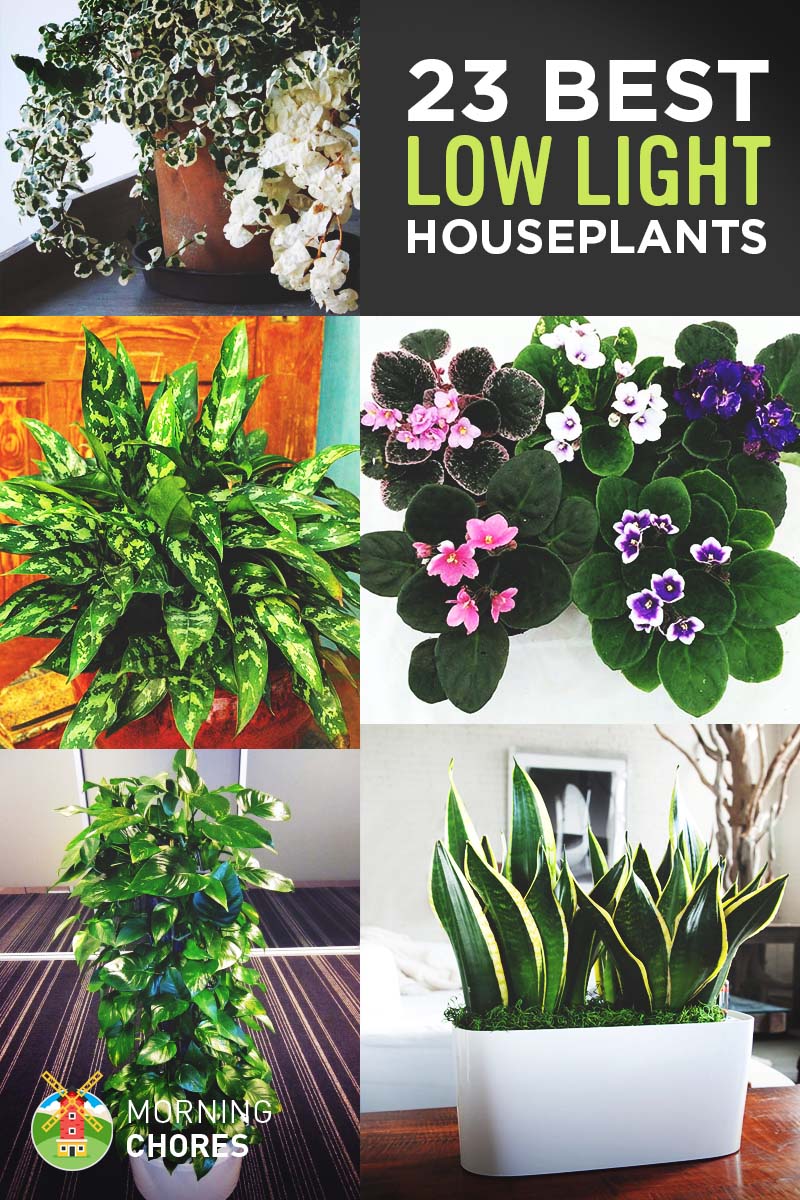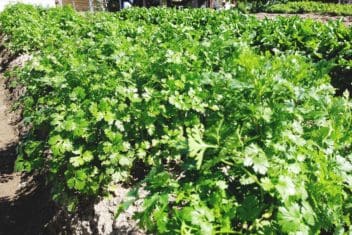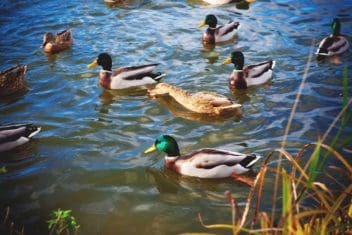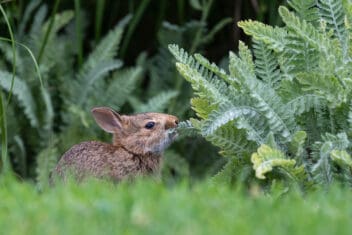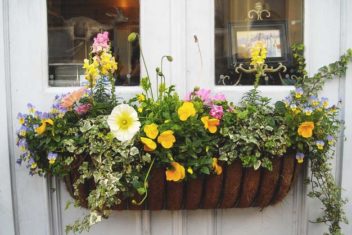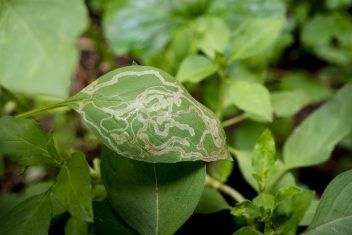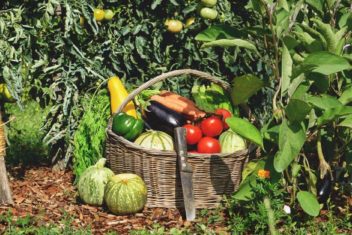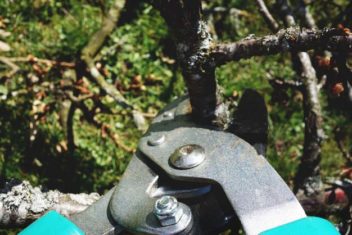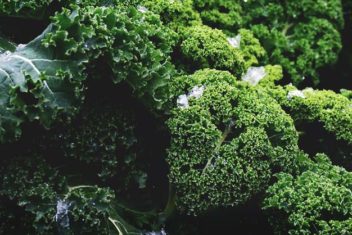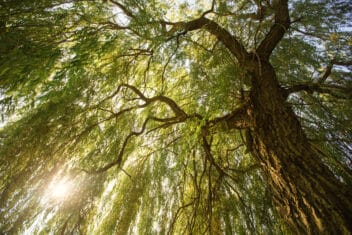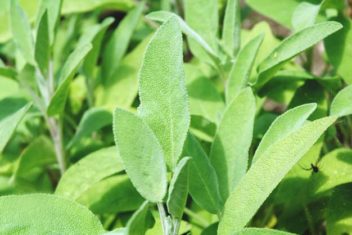It is important that a home is not just a place where we survive, but where we live. People don’t just like their house to be functional, some really want it to feel like home too.
One of the best ways I have found that adds a touch of home to any house is by adding houseplants.
However, the biggest challenge with houseplants is sunlight (and other kinds of maintenance). Our house, for example. We have many windows, but because we live in the woods it is hard to get enough sunlight through these windows.
If you are in the same boat, don’t worry.
I’ve got a list of 23 low-light houseplants that are nearly impossible to kill, even if you don’t have enough time to take care of it.
1. African Violets

African Violets are a personal favorite to many. They have dark-green leaves and the flowers are usually purple; however, at times they can be blue or white as well.
Because they are such small plants, they are great for small spaces.
And they do not require much sunlight.
The most important tip to keeping an African violet healthy and blooming is to set it in water rather than to water it from overhead. These plants are known to stimulate the release of endorphins and adrenaline, which are two hormones that help with stress relief and relaxation.
| Height | 6 in (15cm) |
| Light | Some direct sunlight is fine Eight hours of darkness Grows well under fluorescent light |
| Water | Keep the soil moist but not soggy |
| Humidity | High |
| Temperature | 65-75°F / 18-24°C |
| Buy this plant | Buy on Amazon › |
| Soil | Buy on Amazon › |
| Fertilizer | Buy on Amazon › Every two weeks |
You can actually use any fertilizer other than the one we recommended for each plant. However, make sure you’re not using lawn fertilizer instead because they’re a different kind of food.
2. ZZ Plant
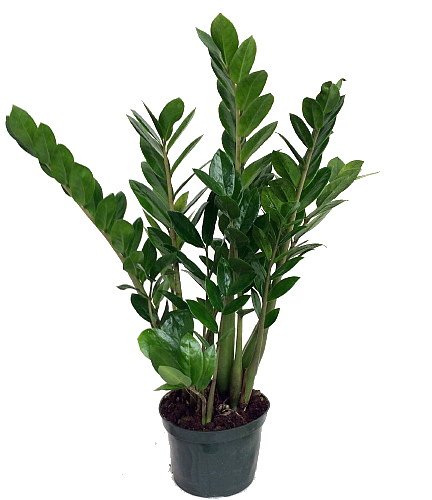
ZZ or ZeeZee is a plant that can withstand neglect.
If you don’t have a green thumb, this is a great plant for you. The worst thing that can be done to this plant is to overwater it. If you wait until the soil is completely dry before watering it, then the plant should do fine.
This plant can take bright light or low light, as long as it is not made to sit in direct sunlight.
The only stipulation that comes with this plant is that it grows to about two feet in diameter. You’ll have to be sure to display it somewhere where it will have room to stretch out.
| Height | 3 ft (90 cm) |
| Light | Keep it out of direct sunlight Bright to low light |
| Water | Allow soil to dry out between waterings |
| Humidity | Average |
| Temperature | 60-75°F / 16-24°C |
| Buy this plant | Buy on Amazon › |
| Soil | Buy on Amazon › |
| Fertilizer | Buy on Amazon › Four times a year |
3. Dracaena
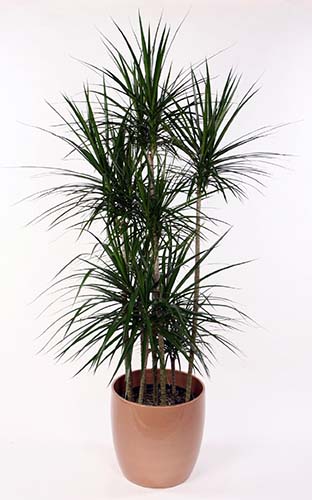
Dracaenas come in many different species.
They are quite an attractive houseplant because they resemble small palm trees. What a great way to “keep” a part of the beach with you!
The biggest hindrance in growing these low-light houseplants is overwatering. But as long as you wait until the soil is dry before re-watering the plant, you should see great success.
A Dracaena produces long glossy leaves and adds life to any home.
| Height | 6 ft (1.8 m) |
| Light | Avoid direct sunlight in summer Bright light |
| Water | Keep soil lightly moist |
| Humidity | Average Tolerates dry air |
| Temperature | 60-75°F / 16-24°C |
| Buy this plant | Buy on Amazon › |
| Soil | Buy on Amazon › |
| Fertilizer | Buy on Amazon › Every two weeks |
4. Parlor Palm
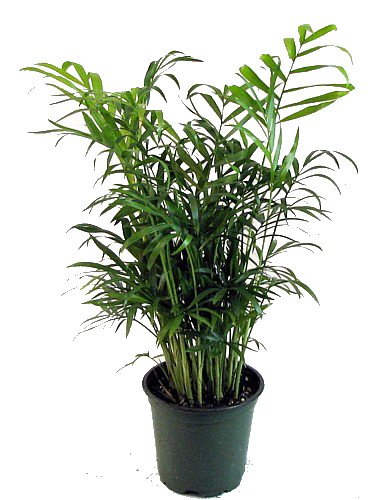
A Parlor Palm is a beautiful plant that adds personality to any room.
Let’s say your house is like mine, and you just don’t get a lot of direct sunlight. In that case, you definitely need one of these plants. This plant is said to grow even in the darkest of corners.
As with the other plants mentioned in this list, don’t overwater this plant. Be sure the soil is completely dry before you add water.
One neat characteristic of this plant is that, if it is placed in an area with a little light, it will bloom in the spring.
| Height | 3-4 ft (90 – 120 cm) Slow-growing |
| Light | Low to moderate |
| Water | Keep soil lightly moist Needs good drainage |
| Humidity | Mist regularly |
| Temperature | 65-80°F / 18-27°C |
| Buy this plant | Buy on Amazon › |
| Soil | Moss-based potting mix and sharp sand 2:1 |
| Fertilizer | Buy on Amazon › Monthly in spring and summer |
5. Umbrella Papyrus
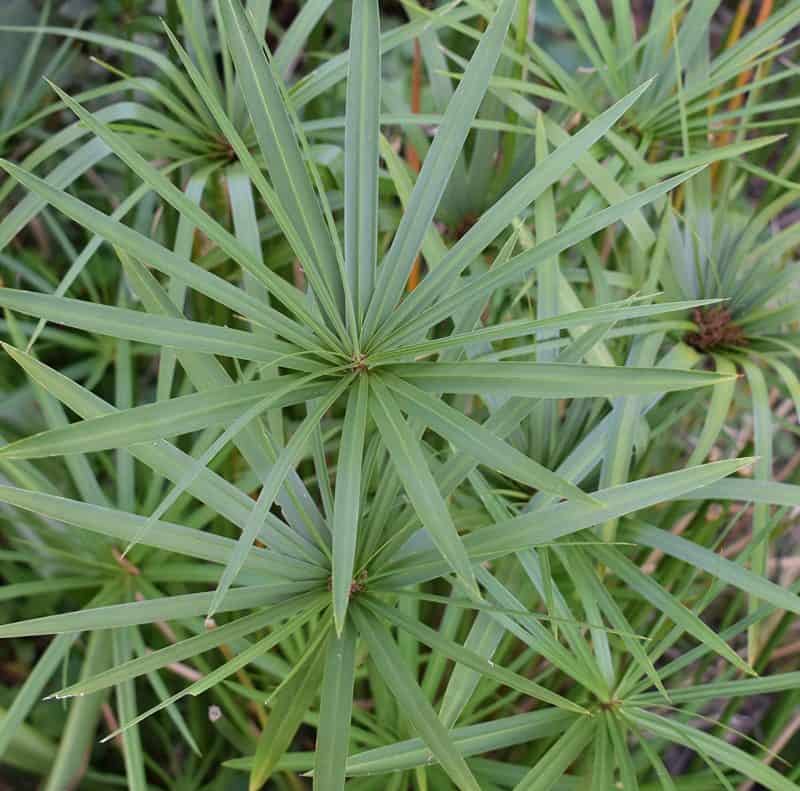
Umbrella Papyrus is a plant that you don’t have to worry about overwatering. You literally place the pot that holds the Umbrella Palm into a huge pot of water so it will be fully submerged.
The only thing you can do wrong with this one is to let it dry out (which would take a very long time).
It does not need direct sunlight. Instead, it likes to be grown in the shade, whether that be in the house or in a garden.
| Height | Up to 10 ft (3 m) |
| Light | Full to low sunlight |
| Water | Keep soil evenly moist |
| Humidity | Average |
| Temperature | 60-75°F / 16-24°C |
| Buy this plant | Buy on Amazon › |
| Soil | Buy on Amazon › |
| Fertilizer | Buy on Amazon › Monthly in spring through fall |
6. Mother-In-Law’s Tongue (a.k.a. Snake Plant)
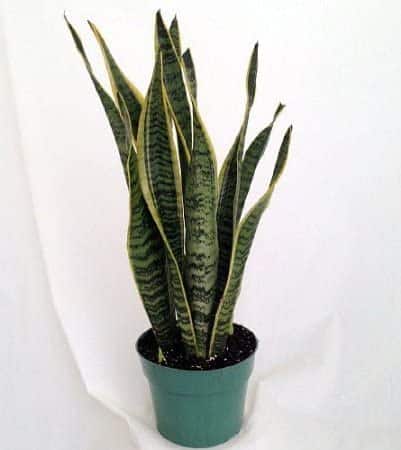
The name of this plant makes me laugh. I think the plant looks more like above-ground seaweed.
It can certainly add that little something extra you desire for your home.
The Snake Plant is known for its durability and its ability to tolerate darkness. If your house is not filled with natural light, this might be the plant for you.
| Height | 2 ft (60 cm) |
| Light | Bright light Tolerate low light |
| Water | Keep soil lightly moist |
| Humidity | Average Tolerate dry air |
| Temperature | 60-75°F / 16-24°C |
| Buy this plant | Buy on Amazon › |
| Soil | Buy on Amazon › |
| Fertilizer | Buy on Amazon › Monthly in spring through fall |
7. Creeping Fig
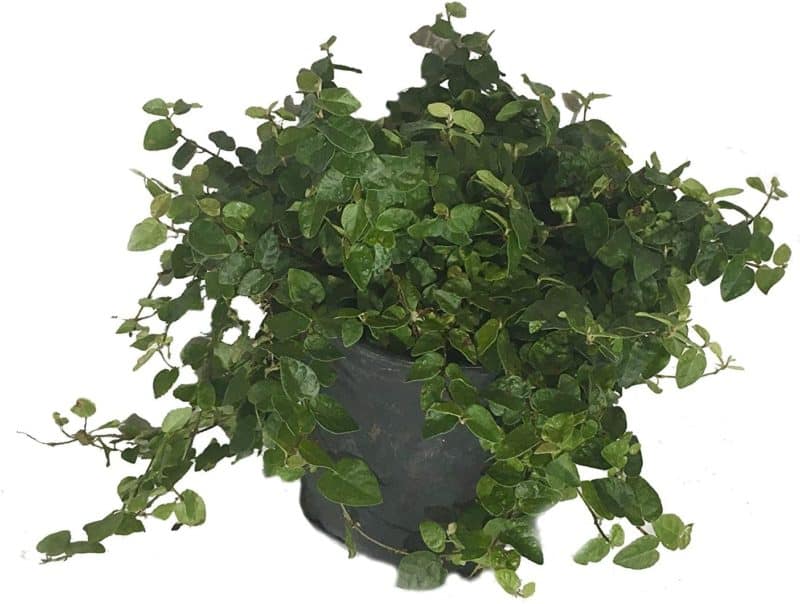
This is another plant that can handle just about everything besides overwatering.
Creeping Pig is an antique-looking plant. It has dark, coiled, leathery and it has a similar appearance to the ivy.
While this plant does not have a lot of colors, it offers a splash of life even to the darkest spaces in your home.
| Height | Trailing to 3 ft (90 cm) |
| Light | Not too much direct sunlight Tolerates low light |
| Water | Keep soil lightly moist |
| Humidity | Moderate to high |
| Temperature | 55-85°F / 13-29°C |
| Buy this plant | Buy on Amazon › |
| Soil | Buy on Amazon › |
| Fertilizer | Buy on Amazon › Monthly in spring through fall |
8. Philodendron
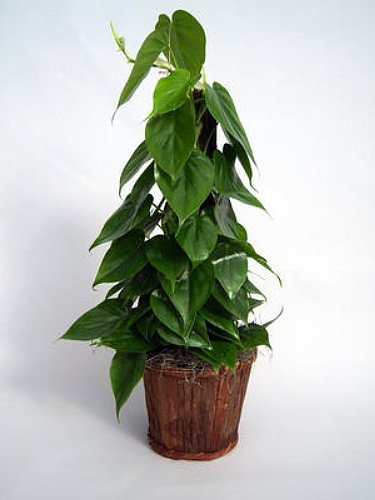
Philodendrons prefer to be kept in moist environments. The soil should not be overly wet; however, it should not be dry.
They say it is best to allow the soil to dry out a little between watering so that you do not run the risk of overwatering.
These plants are great for adding life to a dull room and clearing any stale air.
| Height | Trailing to 4 ft (120 cm) |
| Light | Not too much direct sunlight Tolerates low light |
| Water | Keep soil lightly moist |
| Humidity | Moderate to high |
| Temperature | 60-75°F / 16-24°C |
| Buy this plant | Buy on Amazon › |
| Soil | Peat moss based potting mix |
| Fertilizer | Buy on Amazon › Monthly in spring through fall |
9. Peacock Plant
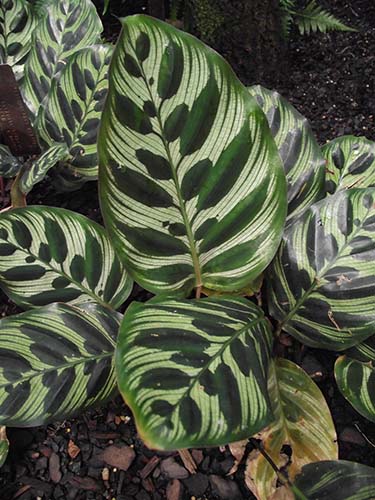
The foliage on this plant is dramatic, and it is one that will surely be talked about.
However, the peacock plant can be a little on the demanding side. It is a low-light houseplant which requires moist air and a minimum temperature of 55° Fahrenheit to be alive. Also, it does like to be watered and maintained in moist soil.
| Height | 2 ft (60 cm) |
| Light | Avoid direct sunlight |
| Water | Keep soil evenly moist |
| Humidity | Requires moist air |
| Temperature | 70-85°F / 21-29°C |
| Buy this plant | Buy on Amazon › |
| Soil | Peat moss based potting mix |
| Fertilizer | Buy on Amazon › Monthly. Do not feed in winter |
10. Prayer Plant
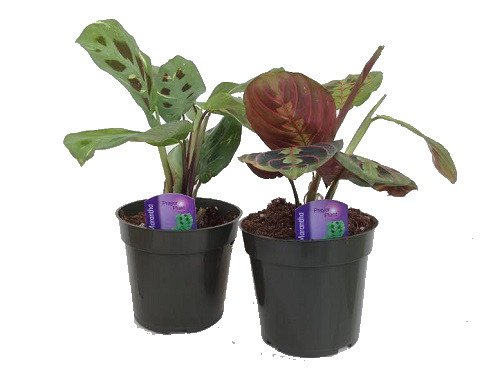
This plant is loved by spider mites, so you have to watch out for that.
The prayer plant only needs indirect sunlight. You don’t want to give it too much sun because the leaves will begin to curl.
It looks similar to Calatheas (Peacock Plant); however, Calathea plants only grow in tropical climates. If you happen to be a fan of Calatheas but don’t live in the right climate, then the Prayer Plant is the answer you’ve been looking for.
| Height | 1 ft (30 cm) |
| Light | Best in bright light No direct sunlight |
| Water | Keep soil evenly moist |
| Humidity | Requires moist air |
| Temperature | 65-80°F / 18-27°C |
| Buy this plant | Buy on Amazon › |
| Soil | Peat-rich potting mix |
| Fertilizer | Buy on Amazon › Every two weeks, spring through fall |
11. Sword Fern
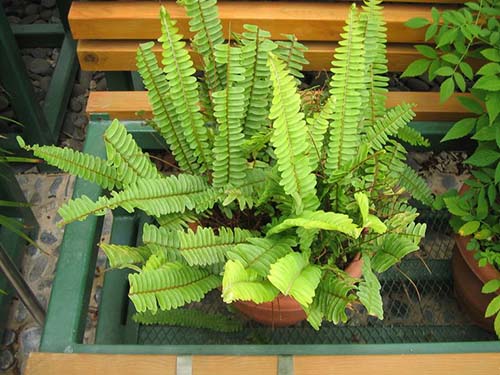
The Sword Fern is what you think of when someone says the word “fern.” It has a beautiful shape and keeps its green color throughout the year.
This plant will not survive in direct sunlight; however, it loves humidity and acidic soil. It needs frequent watering but also needs to be well-drained.
| Height | 6 ft (180 cm) |
| Light | No direct sunlight |
| Water | Keep soil evenly moist in the first year Drought resistant |
| Humidity | Requires moist air |
| Temperature | 65-80°F / 18-27°C |
| Buy this plant | Buy on Amazon › |
| Soil | Buy on Amazon › |
| Fertilizer | Buy on Amazon › Couple times per year |
12. Peperomia
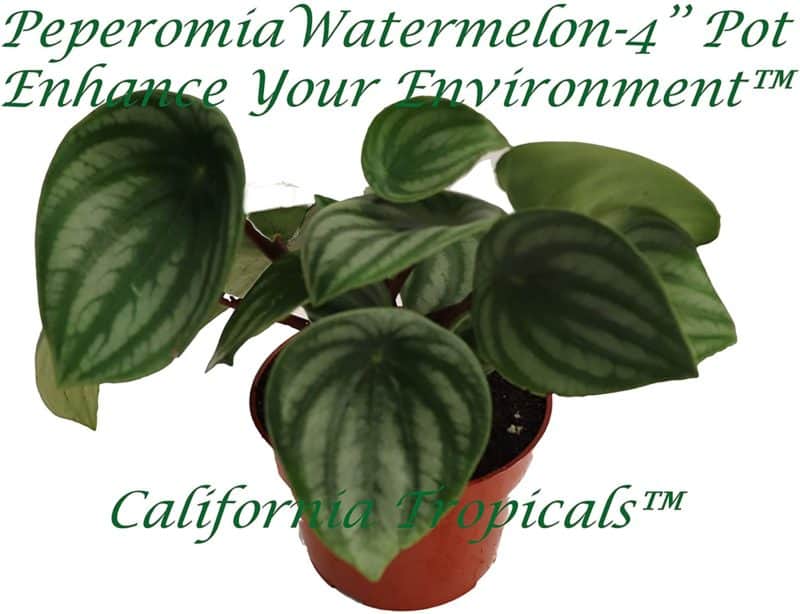
Peperomia is a small low-light houseplant. Many people use the term “adorable” when referring to the Peperomia, as it has an interesting striped pattern that makes it stand out.
This plant loves humidity. To keep its leaves happy, it is important to mist them with a spray bottle.
It loves moist soil but you should reduce the frequency of watering during the winter months.
| Height | 8 ft (20 cm) |
| Light | No direct sunlight Best under fluorescent lights |
| Water | Keep soil barely moist |
| Humidity | Moderate |
| Temperature | 65-75°F / 18-24°C |
| Buy this plant | Buy on Amazon › |
| Soil | Potting mix with perlite or sand |
| Fertilizer | Buy on Amazon › Monthly, spring through fall |
13. African Mask
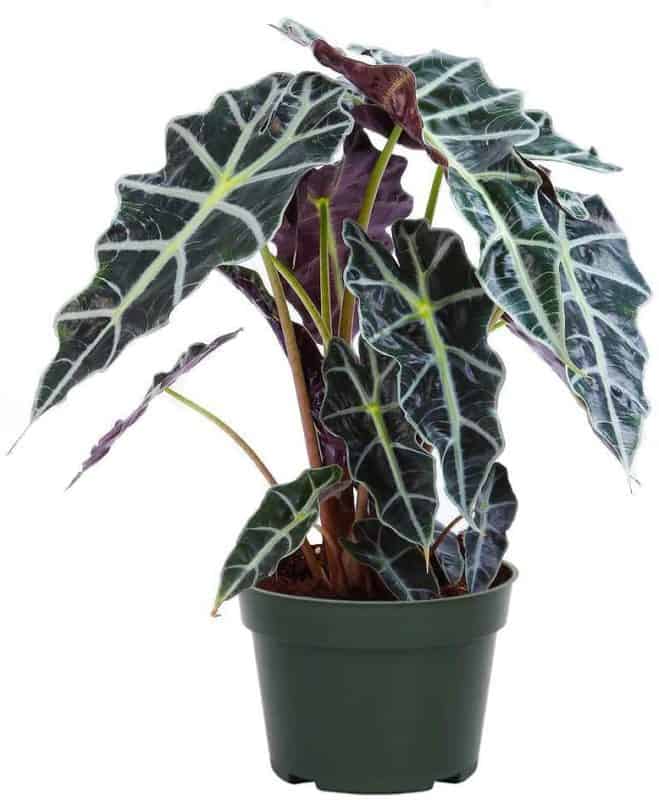
This is a tropical plant that loves humidity. For that reason, the soil must remain moist at all times.
An African Mask needs indirect sunlight. Otherwise, the leaves will wither away. But they love warmth, so these plants grow wonderfully indoors.
It is important to note that these plants are distinct because of the dark purple streak down the backs of their leaves.
| Height | 4 ft (120 cm) |
| Light | No direct sunlight |
| Water | Keep soil evenly moist |
| Humidity | Requires moist air |
| Temperature | 70-85°F / 21-29°C |
| Buy this plant | Buy on Amazon › |
| Soil | Buy on Amazon › |
| Fertilizer | Buy on Amazon › Monthly, spring through fall |
14. Chinese Evergreen
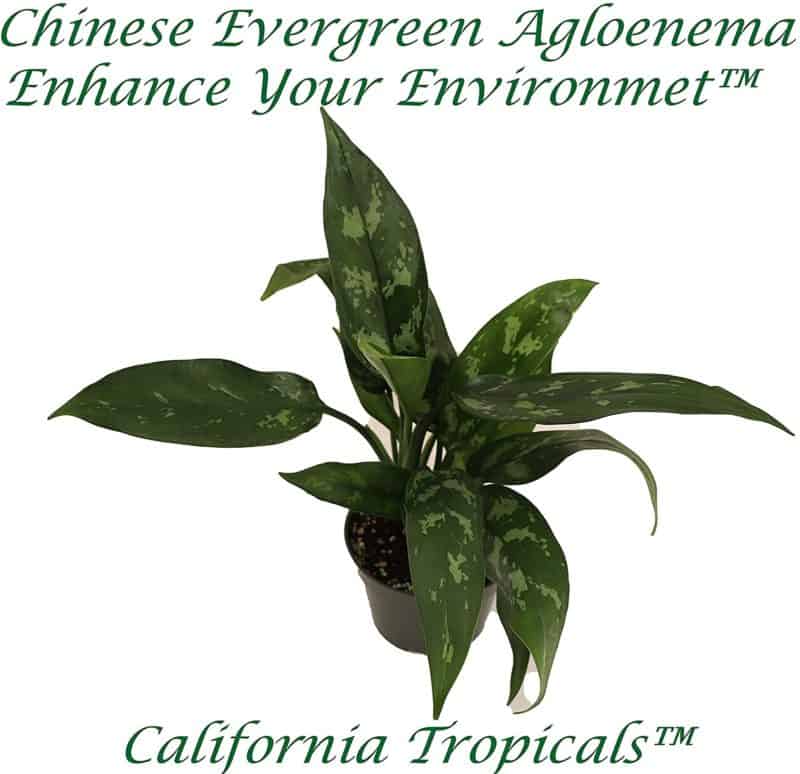
Chinese Evergreens are beautiful ornamental plants. They have a pretty marble pattern on their pointed leaves.
They are specifically known as air-purifying plants.
Chinese Evergreen plants are known for the ease of raising them. All you have to do is dust the leaves off when they become dusty or have bugs. They do not require much water. You should only water them when the soil is completely dry, and then only water to make the soil moist—never wet.
They should not be placed near a draft, as this can cause brown spots on the leaves.
If you are looking for a great low-light houseplant to liven up your house and soothe your mood, this is the plant.
| Height | 3 ft (90 cm) |
| Light | No direct sunlight |
| Water | Keep soil evenly moist |
| Humidity | Average Tolerates low humidity |
| Temperature | 65-75°F / 18-24°C |
| Buy this plant | Buy on Amazon › |
| Soil | Buy on Amazon › |
| Fertilizer | Buy on Amazon › Monthly, spring through summer |
15. Bird’s Nest Fern
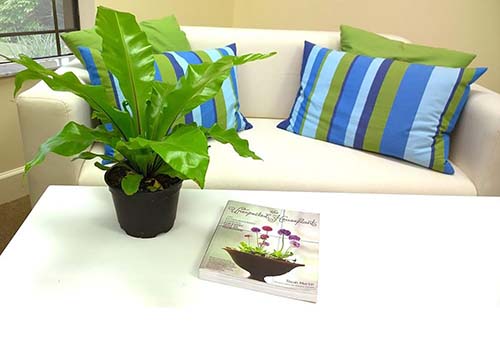
These do not look like your typical ferns.
Originating from rainforests, Bird’s Nest Fern naturally grow on the trunks of huge trees. But they are now grown as houseplants and grow to about 18 inches in height.
These plants obviously love water, as they are from the rainforest. However, the soil cannot be left soggy. If the soil is left soggy, the plant will die.
These plants do love humidity, so it is best to mist their leaves.
You can place them in a tray with pebbles and water, but this can lead to fungal diseases. If by some chance your plant develops a fungal disease, you can cure it by treating the plant with alcohol on a cotton swab.
You should never spray insecticide directly on these plants.
| Height | 2 ft (60 cm) |
| Light | Moderate to bright No direct sun |
| Water | Keep soil evenly moist |
| Humidity | Moderate |
| Temperature | 60-75°F/16-24°C |
| Buy this plant | Buy on Amazon › |
| Soil | Peat moss based |
| Fertilizer | Buy on Amazon › Every two weeks, spring & summer |
16. Cast-Iron Plant
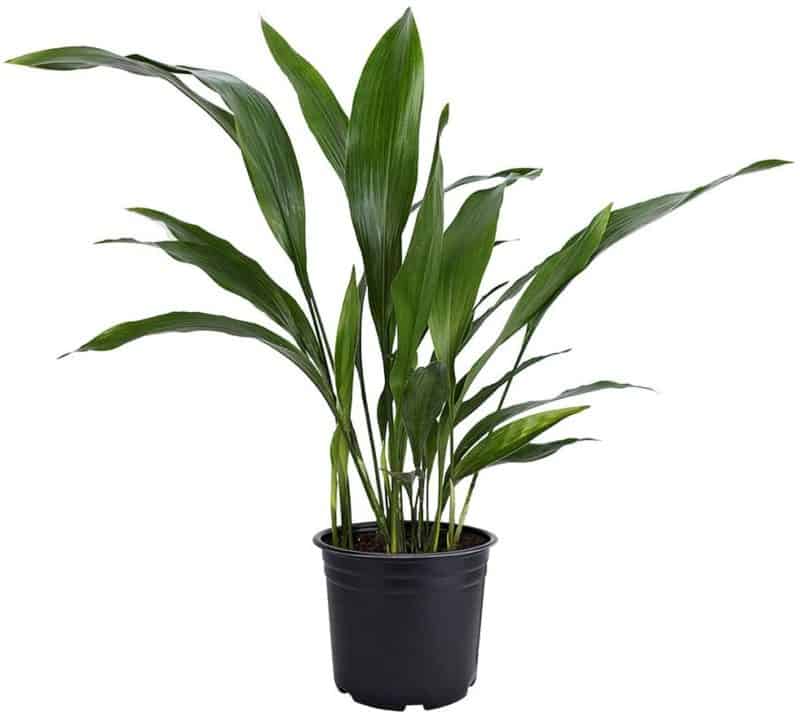
This plant is called the Cast-Iron Plant because it can adapt to and withstand any conditions. This plant does not need much water. It prefers to be planted in soil with some sand so it can drain properly.
Cast-Iron Plants are susceptible to leaf-rotting diseases. This happens when the leaves are left in the water. Be sure to dust the leaves off occasionally.
But, they are capable of withstanding pests, so Cast-Iron Plant is a great low-light houseplant for ease of care.
This plant will bloom little purple flowers that are pleasing to the eyes.
| Height | 3 ft (90 cm) |
| Light | No direct sunlight |
| Water | Water thoroughly Allow soil to dry between waterings |
| Humidity | Average |
| Temperature | 50-85°F/10-29°C |
| Buy this plant | Buy on Amazon › |
| Soil | Buy on Amazon › |
| Fertilizer | Buy on Amazon › Monthly, spring and summer |
17. Silver Queen
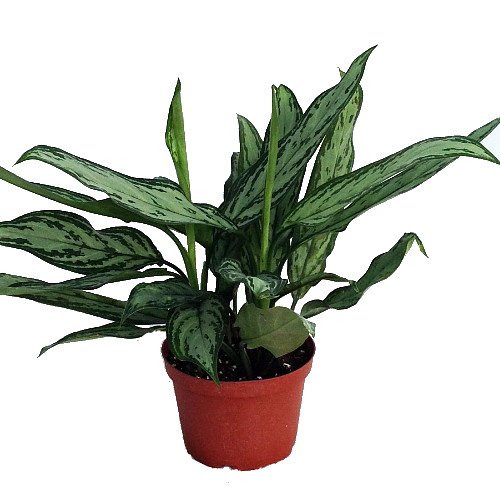
Silver Queen is actually a variant of Evergreen plants (just like Chinese Evergreen)
Though cold sensitive, Silver Queen is great as a low-light houseplant for beginners because it requires little upkeep. They can thrive with little sunlight.
Silver Queens has a beautiful shape that would be great for the décor of any home.
| Height | 2-3 ft (60-90 cm) |
| Light | Low light |
| Water | Keep soil evenly moist |
| Humidity | Average |
| Temperature | 65-75°F/18-24°C |
| Buy this plant | Buy on Amazon › |
| Soil | Buy on Amazon › |
| Fertilizer | Buy on Amazon › Monthly, spring through summer |
18. Peace Lily
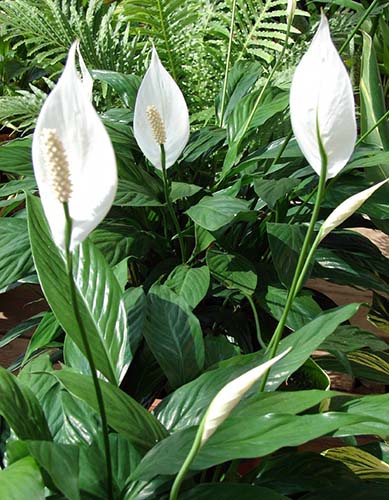
Peace Lily is super easy to grow.
If you are someone that gets so busy around the home and work that you often struggle to keep up with things, this plant is for you. The Peace Lily is great at extending grace to its owners. It can handle going without water for some time.
It is also well known for cleaning up the air inside homes.
| Height | 3 ft (90 cm) |
| Light | Bright, no direct sunlight |
| Water | Keep soil evenly moist Needs good drainage |
| Humidity | 40% or higher |
| Temperature | 65-75°F/18-24°C |
| Buy this plant | Buy on Amazon › |
| Soil | Peat moss based potting mix |
| Fertilizer | Buy on Amazon › Monthly, spring and summer |
19. Spider Plant
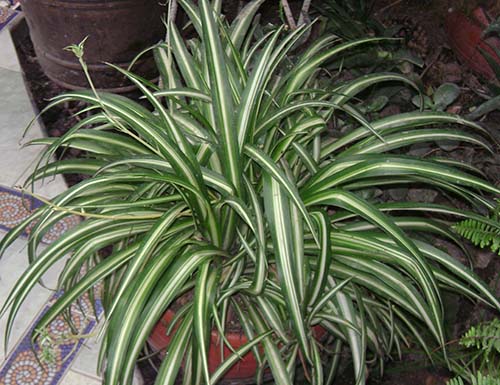
Spider Plants don’t sound beautiful, but they are.
They have beautiful green foliage with cream accents. When they sprout, it is like a beautiful bouffant hairstyle. These low-light houseplants are sure to add life to even the darkest corner in your home.
Many people use them as hanging baskets or as décor for entryways.
They are best in indirect sunlight, as too much sunlight will burn their leaves.
| Length | Trailing to 3 ft (90 cm) |
| Light | Bright, no direct sunlight |
| Water | Keep soil evenly moist |
| Humidity | Moderate |
| Temperature | 65-75°F/18-24°C |
| Buy this plant | Buy on Amazon › |
| Soil | Buy on Amazon › |
| Fertilizer | Buy on Amazon › Every two weeks, spring & summer |
20. Japanese Sedge
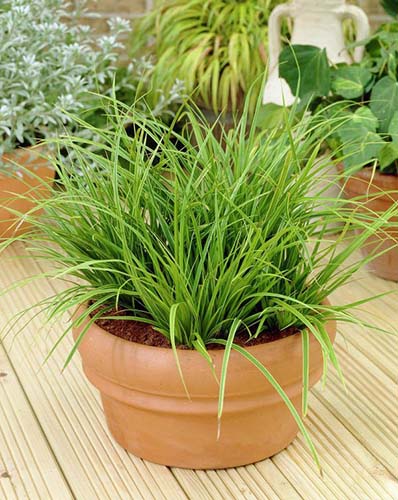
Japanese Sedges remind me of Albert Einstein’s hair-do.
It is an ornamental grass that requires little care. However, it is really pretty low-light houseplant and adds a nice touch to any home.
| Height | 1 ft (30 cm) |
| Light | Bright, partial sun |
| Water | Keep soil evenly moist |
| Humidity | Requires moist air |
| Temperature | 65-75°F/18-24°C |
| Buy this plant | Buy on Amazon › |
| Soil | Buy on Amazon › |
| Fertilizer | Buy on Amazon › Monthly, spring through fall |
21. Money Low-light Houseplant
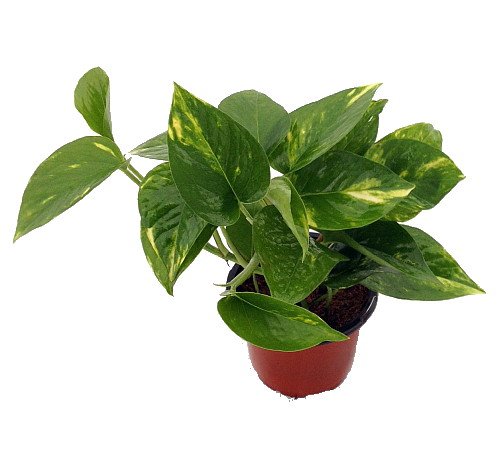
This is also known as Devil’s Ivy. It is a low-light houseplant and low-maintenance, as it thrives with little sunlight.
This plant is great at climbing. It can be grown in almost any room in the house.
One of its most sought-after characteristics is that it is great at cleaning carbon monoxide from the air.
| Height | Up to 8 ft (2.4 m) |
| Light | Low to bright No direct sunlight |
| Water | Allow soil to dry between waterings |
| Humidity | Average |
| Temperature | 60-80°F/16-27°C |
| Buy this plant | Buy on Amazon › |
| Soil | Buy on Amazon › |
| Fertilizer | Buy on Amazon › Every two weeks, spring through fall |
22. Maidenhair Fern
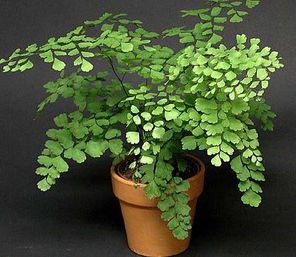
The Maidenhair Fern got its name because it resembles human hair. It looks like a woman’s hair with a perm. It is a beautiful green, leafy plant that only requires indirect sunlight and infrequent watering.
| Height | 6-15 in (15-38 cm) |
| Light | No direct sunlight |
| Water | Keep soil evenly moist |
| Humidity | Requires moist air |
| Temperature | 60-75°F/16-24°C |
| Buy this plant | Buy on Amazon › |
| Soil | Half potting mix, half peat moss |
| Fertilizer | Buy on Amazon › Monthly, spring through summer |
23. Bromeliad
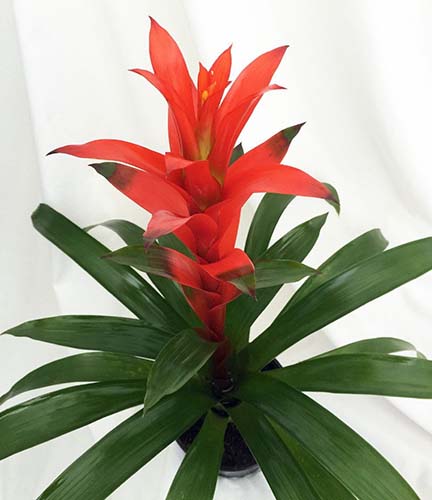
Bromeliads have a unique look.
It is a tropical plant; however, it thrives well in containers. Bromeliads also do well in shaded areas and can even grow under luminescent lights.
| Height | 5 ft (150 cm) |
| Light | No direct sunlight |
| Water | Keep soil evenly moist |
| Humidity | Requires moist air |
| Temperature | 70-85°F / 21-29°C |
| Buy this plant | Buy on Amazon › |
| Soil | Buy on Amazon › |
| Fertilizer | Buy on Amazon › Monthly, spring through fall |
These are the 23 low-light houseplants that I’ve found are forgiving in their care. What houseplants have you grown that did great indoors with little sunlight?
